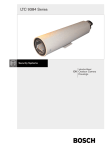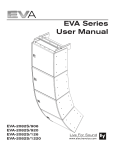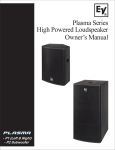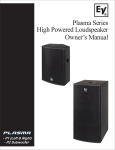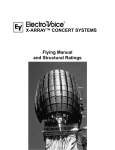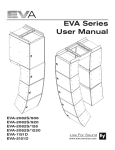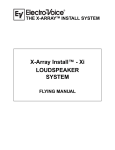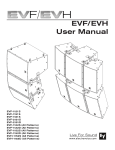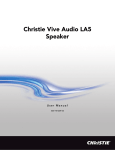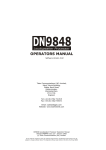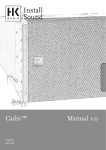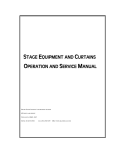Download SxA Service Manual 1_31 - Electro
Transcript
XLC Rigging Manual ELECTRO-VOICE® XLC TM Rigging Manual Table of Contents Rigging-Safety Warning .............................................................................................................................................. 2 0 Introduction .............................................................................................................................................................. 3 1 XLC Rigging System ............................................................................................................................................... 5 1.1 Overview of the XLC Flying System ........................................................................................................ 5 1.2 Enclosure Rigging Hardware Details ....................................................................................................... 5 2 XLC Rigging and Flying Techniques ..................................................................................................................... 10 2.1 Array Considerations ............................................................................................................................. 10 2.2 Rigging an Array Using the XLC Front Dollies ....................................................................................... 10 3 Rigging-Strength Ratings, Safety Factors, and Special Safety Considerations ..................................................... 15 3.1 Working-Load Limit (WLL) and Safety Factor Definitions ...................................................................... 15 3.2 Structural Rating Overview .................................................................................................................... 16 3.3 Simplified Structural-Rating Guidelines ................................................................................................. 16 3.4 Complex Structural-Rating Analysis ...................................................................................................... 18 3.5 Wind Loading ......................................................................................................................................... 24 3.6 Electro-Voice Structural-Analysis Procedures ....................................................................................... 25 4 Rigging Inspection and Precautions ...................................................................................................................... 26 References ............................................................................................................................................................... 28 Notes ........................................................................................................................................................................ 29 1 ELECTRO-VOICE® XLC TM Rigging Manual Rigging-Safety Warning This document details general rigging practices appropriate to the entertainment industry, as they would apply to the rigging of Electro-Voice XLC loudspeaker systems. It is intended to familiarize the reader with standard rigging hardware and techniques for suspending XLC loudspeaker systems overhead. Only persons with the knowledge of proper hardware and safe rigging techniques should attempt to suspend any sound systems overhead. Prior to suspending any Electro-Voice XLC loudspeaker systems overhead, it is essential that the user be familiar with the strength ratings, rigging techniques and special safety considerations outlined in this manual. The rigging techniques and practices recommended in this manual are, of necessity, in general terms to accommodate the many variations in loudspeaker arrays and rigging configurations. As such, the user is expressly responsible for the safety of all specific XLC loudspeaker array designs and rigging configurations as implemented in practice. All the general rigging material contained in this manual is based on the best available engineering information concerning materials and practices, as commonly recognized in the United States, and is believed to be accurate at the time of the original printing. As such, the information may not be directly applicable in other countries. Furthermore, the regulations and requirements governing rigging hardware and practices may be superseded by local regulations. It is the responsibility of the user to ensure that any Electro-Voice loudspeaker system is suspended overhead in accordance with all current federal, state and local regulations. All specific material concerning the strength ratings, rigging techniques and safety considerations for the XLC loudspeaker systems is based on the best available engineering information concerning the use and limitations of the products. Electro-Voice continually engages in testing, research and development of its loudspeaker products. As a result, the specifications are subject to change without notice. It is the responsibility of the user to ensure that any Electro-Voice loudspeaker system is suspended overhead in accordance with the strength ratings, rigging techniques and safety considerations given in this document and any manual update notices. All non-Electro-Voice associated hardware items necessary to rig a complete XLC loudspeaker array (grids, chain hoists, building or tower supports and miscellaneous mechanical components) are the responsibility of others. Electro-Voice July, 2002 ELECTRO-VOICE® XLC TM Rigging Manual 2 0. Introduction The XLC (X-Line Compact) loudspeaker systems represent an important step in line-array technology for small- and medium-scale sound reinforcement. The individual loudspeaker drivers, acoustic lenses, acoustic waveguides, enclosures and rigging hardware were all designed specifically for the XLC product line to not only achieve the highest acoustic output with the highest fidelity, but also to produce a precise wavefront from each element to achieve state-of-theart line-array performance. A brief description of the product line is included below. The XLC loudspeaker systems are shown in Figure 1 with key dimensions and weights. XLC-127: Three-way, LF/MB/HF loudspeaker system with a 120°H x 7.0°V coverage pattern. The system includes one DL12ST 12-inch (305-mm) LF driver, two DM65 6.5-inch (165-mm) MB drivers and two DH2T-16 2-inch (51-mm) HF drivers. The XLC-127 has a switchable crossover that allows either biamp or triamp operation. The XLC-127 utilizes an enclosure that is trapezoidal in the vertical plane (with an 8° total included angle) and has the standard XLC 8° rigging frame secured to the left and right enclosure sides. XLC-127+: Three-way, LF/MB/HF loudspeaker system with a 120°H x 7.0°V coverage pattern. The system includes one DL12ST 12-inch (305-mm) LF driver, two DM65 6.5-inch (165-mm) MB drivers and two ND6-16 3-inch (76-mm) HF drivers. The XLC-127+ has a switchable crossover that allows either biamp or triamp operation. The XLC-127+ utilizes the same 8° trapezoidal enclosure as the XLC-127 and has the same standard XLC 8° rigging frame secured to the left and right enclosure sides. XLC-118: Subwoofer loudspeaker system with one EVX180B 18-inch (457-mm) woofer. The XLC-118 utilizes an enclosure that is trapezoidal in the vertical plane (with a 12° total included angle) and has the standard XLC 12° rigging frame secured to the left and right enclosure sides. 22.50in (572mm) 8.31in (211mm) Rear View 19.44in (494mm) Weight: 116 lb (52.6 kg) Center of Gravity Center of Gravity 39.00in (991mm) Top View 8.31in (211mm) Ref 11.02in (280mm) Cent. CL Side View 14.25in (362mm) Front View (Without Grille) Figure 1a: XLC-127 Loudspeaker System 3 ELECTRO-VOICE® XLC TM Rigging Manual 22.50in (572mm) 7.94in (202mm) Rear View 19.56in (497mm) Weight: 111 lb (50.3 kg) Center of Gravity 39.00in (991mm) Top View 7.94in (202mm) Ref Center of Gravity 11.02in (280mm) Cent. CL 14.25in (362mm) Side View Front View (Without Grille) Figure 1b: XLC-127+ Loudspeaker System 22.50in (572mm) 9.38in (238mm) 19.50in (495mm) Rear View Weight: 120 lb (54.4 kg) Center of Gravity 9.38in (238mm) Ref 16.64in (423mm) Cent. CL Side View Center of Gravity 39.00in (991mm) Top View 21.44in (545mm) Front View (Without Grille) Figure 1c: XLC-118 Loudspeaker System ELECTRO-VOICE ® TM Rigging Manual XLC 4 1. XLC Rigging System 1.1 Overview of the XLC Flying System The XLC loudspeaker systems have been designed to construct acoustic line arrays. Acoustic line arrays typically consist of independent columns of loudspeaker systems. This simplifies the rigging system. The XLC loudspeaker enclosures utilize a hinged rigging system that makes constructing arrays easy, predictable and repeatable. This front-hinging rigging concept allows arrays to be constructed with the least possible spacing between enclosures. The front and back rigging hardware for linking two enclosures together are captured as an integral part of the side rigging frames. A basic array is shown in Figure 2 that illustrates the integral components that make up a typical XLC flying system. The XLC enclosures are vertically trapezoidal - taller at the front than at the back. The enclosures are hinged at the front corners using rigging hardware specially designed for the XLC system. The enclosures are linked at the rear using rigging arms that have multiple attachment positions. The different positions adjust how close the back corners of the enclosures are pulled together; hence, adjusting the vertical angle of the bottom enclosure. 1.2 XLC Enclosure Rigging Hardware Details On each side of the enclosure is an XLC rigging frame assembly. All the rigging hardware needed to fly a column of XLC enclosures is an integral part of a high-strength aluminum-alloy rigging frame. The structural load is transmitted through the frame minimizing the load on the loudspeaker enclosure shell. Figure 3 illustrates the XLC enclosure rigging hardware components. Figures 4a and 4b show key dimensions for the rigging hardware. At the front of the frame is a rectangular rigging tube. Captured inside the rigging tube is a rigging connector called the button bar. The button bar is constructed from a high-strength aluminum alloy. The button bar can slide out the top of the tube and be locked into position as shown in Figure 2. The portion of the button bar sticking out the top would be inserted into the front rigging tube of an enclosure above, linking the two enclosures together and forming a hinging point between the two enclosures. The button bar can also be fully retracted inside the tube for transportation. Each button bar has two spring-loaded buttons that extend out of the bar. The front rigging tube has two holes that lock the buttons from the bar in place. As shown in Figure 3, the bottom button locks the button bar in place at the top of the tube. The exposed top button is then used to lock the button bar in the tube of an enclosure above. For transportation, the button bar would be slid down inside the tube and would be locked in the tube using the top button. At the rear of the frame is a rigging slot. Captured inside the rigging slot is a rigging connector called the swing arm. The swing arm is constructed from a high-strength aluminum alloy. The swing arm can be pivoted to stick out the top as shown in Figure 3. At the bottom of the frame, the rear rigging slot has a series of holes. 5 ELECTRO-VOICE® XLC TM Rigging Manual Hoist Motor Grid Swing Arm Button Bar Eight XLC Enclosures Hinged at the Front by the Button Bars and Front Rigging Tubes Angles Between Enclosures fixed by Pins through the Swing Arms and Rear Rigging Slot Holes XLC Enclosures Figure 2: Typical XLC Flying System The swing arm from an enclosure below can be pivoted up so that one of the quick-release pins may be inserted through the holes in the rigging slot on the frame and the slot in the swing arm, linking the two enclosures together. The vertical tilt angle of the bottom enclosure is then determined by the hole in which the swing arm is pinned. The XLC-127 and XLC-127+ enclosures may be angled from 0° to 8° in 1° increments, while the XLC-118 enclosure may be angled from 0° to 12° in 1° increments. The angle adjustment holes are detailed in figures 4a and 4b. This pin fixes the maximum distance the back corners of the enclosures may be separated. ELECTRO-VOICE® XLC TM Rigging Manual 6 Specifically, this means that when the enclosures are suspended, the back of the bottom enclosure will rotate down until the pin is stopped at the end of the slot in the swing arm. This one pin will not prevent the back corners of the enclosures from coming together. When landed, the enclosures will compress together until their back corners touch. The enclosures can be locked apart by inserting a second quick-release pin in the rear rigging holes directly above the first pin at the end of the swing arm as shown in Figure 5. With a second pin, the swing arm becomes immobile and the array becomes rigid so that when it is landed, the enclosures are locked at the selected angles. Two quick-release pins on lanyards are attached to the rear rigging frame for pinning the swing arm. An XLC system can often be flown using only a single pin - the one that passes through the slot in the swing arm. The choice of whether to add the second pin is left to the user. This decision is often based on personal preferences regarding the technique of transferring the enclosures from the array to dollies for transport in touring applications. In some situations, however, the second pin is required. Two pins must always be used whenever a pull back is necessary to tilt the entire array downward more than gravity will allow. If a second pin is not used, the shape of the array will change as the pull back is applied. Another example where a second pin is required is when an array with a large vertical arc is created. Gravity may not allow all the enclosures to be angled apart as much as necessary. In this case, the second pin is necessary to hold the enclosures apart to achieve the desired array shape. If the user decides not to use the second pin to hold enclosures apart at the rear, the pin should be installed in the swing-arm transport hole to prevent it from dangling and catching on something or getting in the way. Using this hole, the swing arm may be pivoted down into the rigging slot on the frame and pinned into its fully retracted position for transport. Front Button Bar Rear Swing Arm Quick-Release Pins to Lock Swing Arm in Rear Rigging Slot Top Spring-Loaded Locking Button Swing-Arm Slot Bottom SpringLoaded Locking Button XLC Enclosure Swing-Arm Transport Hole Hole in Rigging Tube for Locking Button Rear Rigging Slot Button Bar Knob Front Rigging Tube Holes in Rigging Slot to Pin the Swing Arm from the Box Below Hole in Rigging Tube for Locking Button Figure 3a: XLC Rigging Hardware 7 ELECTRO-VOICE® XLC TM Rigging Manual 20.90in (531mm) 0.38in (9.7mm) 1.00in (25.4mm) Typ. 1.22in (31.0mm) Typ. 38.22in (971mm) Cent. R4.94in (125mm) 8.75in 5.63in (222mm) (143mm) Typ. CL 4.88in (124mm) 4.75in (121mm) Side View Front View (With Grille) 0.65in (16.5mm) Typ. Dia .385in (9.8mm) (11 Plcs.) 7° Hole .730in (18.5mm) Typ. .730in (18.5mm) Typ. 5° Hole 3° Hole 1° Hole 37.53in (953mm) Cent. 8° Hole 6° Hole 4° Hole 2° Hole 0° Hole .365in (9.3mm) .300in (7.6mm) Hole Detail Scale = 3:1 Rear View Figure 4a: XLC-127 and XLC-127+ Rigging Dimensions ELECTRO-VOICE® XLC TM Rigging Manual 8 20.90in (531mm) 0.32in (8.1mm) 1.00in (25.4mm) Typ. 38.22in (971mm) Cent. 1.22in (31.0mm) Typ. R6.30in (160mm) 9.22in 12.34in (234mm) (313mm) Typ. 7.79in (198mm) CL 7.67in (195mm) Side View Front View (With Grille) 0.65in (16.5mm) Typ. Dia .385in (9.8mm) (15 Plcs.) 12° Hole 11° Hole 10° Hole 9° Hole 8° Hole 7° Hole 6° Hole 5° Hole 4° Hole 3° Hole 2° Hole 1° Hole 0° Hole .737in (18.7mm) Typ. .737in (18.7mm) Typ. .368in (9.4mm) 37.53in (953mm) Cent. .300in (7.6mm) Hole Detail Scale = 3:1 Figure 4b: XLC-118 Rigging Dimensions CORRECT Rear View INCORRECT = Pin 9 Figure 5: Dual Locking Pin Rigging Configurations ELECTRO-VOICE® XLC TM Rigging Manual 2. XLC Rigging and Flying Techniques 2.1 Array Considerations The XLC loudspeaker systems have been specifically designed to construct acoustic line-arrays. Line-array systems typically consist of independent columns of loudspeaker enclosures. The most common implementation would be a stereo sound reinforcement system with two columns (left and right). Additional columns of loudspeakers are sometimes added to cover different seating sections of a venue seating areas that wrap around the side or back of a stage, for example. The XLC line arrays will consist of columns of XLC-127 or XLC-127+ 120°H x 7°V full-range systems. The exact number of XLC loudspeaker systems in a column will vary depending on the vertical acoustic coverage required for the specific venue. Furthermore, the relative vertical angles between the boxes will also depend on the venues acoustic coverage requirements. (Acoustic design techniques are outside the scope of this document and the reader is directed to the XLC modeling software available from the Electro-Voice website for acoustic design assistance.) It is also possible to construct subwoofer line arrays using the XLC-118 systems. Although the full-range XLC loudspeaker systems shown in Figure 1 are not physically symmetrical, their acoustical polar responses are substantially symmetrical because the highfrequency sections are in the center of the enclosures. Thus, stereo left and right arrays, or leftcenter-right arrays may be constructed with the loudspeakers in their normal right-side-up orientation as shown in Figure1. XLC-127 AND XLC-127+ LOUDSPEAKER SYSTEMS SHOULD NOT BE MIXED IN THE SAME LINE-ARRAY COLUMN BECAUSE THEIR ACOUSTIC TIME AND PHASE RESPONSE IS DIFFERENT. BOTH THE XLC-127 AND XLC-127+ HAVE AN INTERNAL CROSSOVER THAT MAY BE SWITCHED IN OR OUT, ALLOWING THE SYSTEMS TO BE TRIAMPED OR BIAMPED. TRIAMPED AND BIAMPED SYSTEMS MUST NOT BE MIXED IN THE SAME LINE-ARRAY COLUMN BECAUSE THEIR ACOUSTIC TIME AND PHASE RESPONSE IS DIFFERENT. 2.2 Rigging an Array Using the XLC Front Dollies The XLC loudspeaker systems have front-mount dollies available for transportation. The XFD-118 is a front dolly for the XLC-118 subwoofer, while the XFD-127 is a front dolly for XLC-127 and XLC-127+ full-range systems. Each side of the dolly has a quick-release clip that latches to the rigging frame on the side of the enclosure. Figure 6 illustrates the technique used to construct a loudspeaker array with enclosures transported on front dollies. First, several enclosures are rolled into position for an array, as shown in Figure 6a. The enclosures should be pushed tight against each other. Next, take the front button bar that is retracted inside from the rigging tube of one enclosure and slide it into the front rigging tube of the adjacent enclosure, as shown in Figure 6b. To release the bar from its locked position in the first enclosure, push in the spring-loaded blue button until it can clear the round cutout in the side of the rigging tube. While holding down the button, grab the button bar knob that is protruding through the rear of the rigging tube and slide the entire button-bar assembly into the front rigging tube of the adjacent enclosure. ELECTRO-VOICE® XLC TM Rigging Manual 10 MAKE SURE THAT THE SPRING-LOADED BUTTONS ON THE BUTTON BARS FULLY LOCK INTO THE ROUND HOLES IN THE FRONT RIGGING TUBES ON BOTH ENCLOSURES. REPEAT THIS FOR EVERY ENCLOSURE ON BOTH SIDES OF THE LINE ARRAY. Attach the top enclosure in the array to the grid, as shown in Figure 6c. (Only an XLC compatible grid can be used with an XLC array.) The grid has front rigging tubes just like the enclosures. Slide the front button bar of the top enclosure into the front tube of the grid using the same technique that was used to link two enclosures. MAKE SURE THAT THE SPRING-LOADED BUTTONS ON THE BUTTON BARS FULLY LOCK INTO THE ROUND HOLES IN THE FRONT RIGGING TUBES ON BOTH THE ENCLOSURE AND THE GRID. The grid also has a rear rigging slot just like the enclosures, except that the grid only has one attachment hole available. Unlock the rear swing arm from the top enclosure by removing the quick-release pin from the rear rigging frame on the enclosure. Pivot the rear swing arm on the enclosure up into the rear rigging slot on the grid. Insert the quick-release pin from the grid through the holes in the rear rigging slot in the grid and through the slot in the swing arm. Repeat the process for the other side of the enclosure and grid. MAKE SURE THAT THE QUICK-RELEASE PIN IS FULLY LOCKED IN THE REAR OF THE GRID AND THAT THE SWING ARM FROM THE ENCLOSURE IS SECURED. Now begin to lift the grid and the upper portion of the loudspeaker array, as shown in Figure 6d. As the loudspeakers are lifted, the back corners of the loudspeaker enclosures will come together. Pause when several loudspeakers are lifted off the ground. Unlock the rear swing arms on the back of the enclosures by removing the quick-release pins in the frames. Pivot the rear swing arms up into the rear rigging slots on the enclosures above, as shown in Figure 6e. Insert the quick-release pin into the hole on the upper enclosure that will give the desired vertical splay angle and through the slot on the swing arm. Make sure that the quick-release pin on the upper enclosure is fully locked in the rigging frame and that the swing arm is fully secured. Repeat this process for all the suspended enclosures on both sides of the array. ON EACH ENCLOSURE, ALWAYS MAKE SURE THAT THE LEFT AND RIGHT SWING ARMS ON THAT ENCLOSURE ARE LOCKED INTO THE SAME HOLES FOR THE SAME VERTICAL SPLAY ANGLE. THE QUICK-RELEASE LOCKING PINS ARE TETHERED TO THE REAR RIGGING FRAME WITH A LANYARD. THE QUICK-RELEASE PINS MUST ONLY BE LOCKED IN THE REAR RIGGING HOLES ON THE FRAME TO WHICH IT IS TETHERED. NEVER USE THE PINS FROM ONE ENCLOSURE TO LOCK INTO ANOTHER ENCLOSURE. Remove the front dollies from the suspended enclosures. Grab the clips on the sides of the dollies and pull them away from the sides of the enclosures until they unlatch from the rigging frame. Continue lifting the array until additional enclosures are suspended. Then pause again and repeat the process as described above. Continue this procedure until all the loudspeakers are rigged at the back. 11 ELECTRO-VOICE® XLC TM Rigging Manual Initially, the rear rigging will be slack as the array is lifted. As more enclosures are suspended, the rear swing arms in the top enclosures will go into tension. If it is desired to lock the enclosures at their vertical splay angles when in compression as well as in tension, the lifting should be paused so that the second quick-release pin can be installed in the hole immediately at the end of the swing arm. For most arrays, the second pin is not necessary. Second pins are usually only necessary when a pull back is used, or when arrays with large arcs are assembled. (See Section 1.2 of this manual for a detailed discussion of when to use a second pin.) If the user does not want to use a second pin, this step can be eliminated. Secure any unused pins into the swing-arm transport hole in the frame. To disassemble the array, reverse the steps outlined in this section. THE ENCLOSURES MUST BE BROUGHT OUT OF COMPRESSION AND THE SECOND LOCKING PIN REMOVED BEFORE THE ARRAY IS LOWERED TO THE GROUND FOR DISASSEMBLY. ELECTRO-VOICE® XLC TM Rigging Manual 12 Figure 6a: Flying XLC Systems with Front Dollies - Step 1 Figure 6b: Flying XLC Systems with Front Dollies - Step 2 Figure 6c: Flying XLC Systems with Front Dollies - Step 3 13 ELECTRO-VOICE® XLC TM Rigging Manual Dolly Clip Figure 6d: Flying XLC Systems with Front Dollies - Step 4 Figure 6e: Flying XLC Systems with Front Dollies - Step 5 ELECTRO-VOICE® XLC TM Rigging Manual 14 3. Rigging-Strength Ratings, Safety Factors, and Special Safety Considerations 3.1 Working-Load Limit and Safety Factor Definitions The structural ratings for all of the XLC rigging components and complete loudspeaker systems are based on test results in which parts were stressed to failure. Manufacturers typically present the structural-strength ratings of mechanical components or systems as either the working-load limit (WLL) or the ultimate-break strength. Electro-Voice chooses to present the structural-load ratings of the XLC loudspeaker systems as the working-load limit. The working-load-limit rating represents the maximum load that should ever be applied to a mechanical component or system. THE USER SHOULD NEVER APPLY A LOAD THAT EXCEEDS THE WORKINGLOAD LIMITS OF ANY OF THE RIGGING COMPONENTS OR COMPLETE LOUDSPEAKER SYSTEMS DESCRIBED IN THIS MANUAL. The working-load limits for the XLC rigging components and complete loudspeaker systems described in this manual are based on an 8:1 safety factor. The safety factor is defined as the ratio of the ultimate-break strength divided by the working-load limit, where the ultimate-break strength represents the force at which a part will structurally fail. For example, if a part has working-load limit of 1,000 lb (454 kg), it would not structurally fail until a force of at least 8,000 lb (3,629 kg) was applied, based on a 8:1 safety factor. However, the user should never apply a load to that part that exceeds 1,000 lb (454 kg). The safety factor provides a margin of safety above the working-load limit to accommodate normal dynamic loading and normal wear. CAUTIONS for Working-Load Limits and Safety Factors The working-load limits defined by the manufacturer of any rigging component should never be exceeded. Electro-Voice bases the working-load limits of its XLC products on an 8:1 safety factor. Other manufacturers of rigging components may base their working-load limits on safety factors other than 8:1. For example, 5:1 safety factors are fairly common amongst rigging manufacturers because many regulatory agencies call for a minimum safety factor of 5:1. When an XLC loudspeaker system is installed where local regulations only require a safety factor of 5:1, Electro-Voice insists that the working-load limits of the XLC rigging never be exceeded and that an 8:1 safety factor be maintained for the XLC loudspeakers. The user is cautioned that some local regulations may require safety factors higher than 8:1. In that circumstance, Electro-Voice insists that the user maintain the higher safety factor as required by the local regulations throughout the entire XLC installation. It is the responsibility of the user to make sure that any XLC installation meets any applicable local, state or federal safety regulations. 15 ELECTRO-VOICE® XLC TM Rigging Manual 3.2 Structural Rating Overview There are two independent strength ratings that, together, give a complete description of the overall structural performance capabilities of any XLC loudspeaker system. They are defined as follows: 1. The strength of each individual rigging point; which is the combined strength of the rigging frame, the rigging frame components (front button bars, rear swing arm, quick-release pins, etc.) and the enclosure. 2. The total strength of the overall enclosure; which is a function of the combined forces from all of the rigging points acting on the rigging frames and enclosure as a whole. The array designer must be aware of the working-load-limit ratings and the loads being applied to the individual rigging points and the overall enclosure. An XLC loudspeaker system is only as strong as its weakest link. It is usually the case that one of the working-load limits will be approached sooner that the other. WHEN SUSPENDING ANY XLC LOUDSPEAKER SYSTEM OVERHEAD, THE WORKING-LOAD LIMITS MUST NEVER BE EXCEEDED FOR EACH INDIVIDUAL RIGGING POINT, OR THE OVERALL ENCLOSURE. The forces acting on each individual rigging point and on the overall enclosures in an XLC flying system will vary with each array configuration. Determining the forces throughout an array requires complex mathematical calculations. Electro-Voice engineers have, however, defined a set of simplified structural-rating guidelines that eliminate the need for the complex calculations for most array configurations. The interaction of the complex forces throughout arrays were analyzed to develop this set of conservative guide-lines, presented below, to enable a rigger to immediately determine on site whether or not an array is safe without having to make weight-distribution calculations. The structural-strength ratings of the individual rigging points and the overall XLC enclosures are also presented below so that a complex structural analysis can be made for any array configuration. The reader should consult an experienced structural engineer to perform the complex structural analysis. The reader is directed to the References section of this manual for a list of rigging references (for background in general rigging practice) and mechanical engineering references (for background in structural engineering analysis). 3.3 Simplified Structural-Rating Guidelines Electro-Voice engineers have defined a set of simplified structural-rating guidelines that will enable a rigger to immediately evaluate the safety of an XLC system on site without having to make complex force-distribution calculations. A combination of destructive testing and computer modeling were used to analyze the complex forces throughout arrays. Conservative working-load ratings were utilized to simplify the guidelines. Therefore, array configurations other than those illustrated in these simplified guidelines may be permissible for those applications, consult section 3.4 Complex Structural-Rating Analysis for a detailed structural analysis. The simplified structural-rating guidelines are shown in Figure 7. (Note that there is a label on the back of each flying XLC loudspeaker enclosure that includes the graphics shown in Figure 7.) ELECTRO-VOICE® XLC TM Rigging Manual 16 These guidelines provide a simplified rating for typical arrays based on the: 1. Vertical angle of each enclosure 2. Total weight of that enclosure plus all of the enclosures and rigging hung below it. 3. Angles of the force components on the front button bars and the rigging frames relative to the enclosures. 4. Angles of the force components on the rear swing arms, quick-release pins and rigging frames relative to the enclosures. 2200 2000 1800 1000 1600 1400 700 1200 1000 800 500 400 600 400 200 200 0 -90 900 800 600 300 100 -60 -30 -0 30 60 0 90 Figure 7: Simplified XLC Rigging-Rating Guidelines 17 ELECTRO-VOICE® XLC TM Rigging Manual Figure 7 includes a graph of the working-load weight-versus-angle limit rating for the XLC enclosures. This working-load weight limit is applicable to every enclosure in an array, and includes the weight of that enclosure plus the total weight of all enclosures and rigging hardware suspended below it. The absolute enclosure angle is the vertical angle of that enclosure, where 0° represents an upright enclosure facing straight ahead (0° elevation angle). These working-Ioad-versus-angle limits take into account the complex forces generated in the front button bars, the rear swing arms, the quick-release pins, the rigging frames, the enclosures and the (optional) pull-up line, as a result of the complex weight distribution throughout the array. Also included in the simplified structural-rating guidelines in Figure 7 are side-to-side and front-toback angle limits for the front button bars and rear rigging arms on the top enclosure. WHEN APPLYING THE SIMPLIFIED STRUCTURALRATING GUIDELINES TO ANY XLC LOUDSPEAKER SYSTEM SUSPENDED OVERHEAD, THE USER MUST OBEY THE FOLLOWING RULES: 1. Never exceed the working-Ioad-versus-angle limit for any enclosure in the array. 2. Never exceed the side-to-side angle limits for the front button bar assemblies on any enclosure. 3. Never exceed the side-to-side angle limits for the rear swing arm assemblies on any enclosure. 4. Always make sure that every front button bar is securely locked in the front rigging tube on every enclosure (and grid, when applicable) before lifting overhead. 5. Always make sure that every rear swing arm is securely locked in the rigging frame with the quick-release pins on every enclosure (and grid, when applicable) before lifting overhead. 6. If a pull-up grid is used, never exceed the side-to-side angle limits for the pull-up grid. Discussion of Array Examples: For example, if the top enclosure in a column was angled down 30°, the enclosure working-Ioad-versus-angle limit from the simplified structural-rating guidelines shown in Figure 7 would indicate that a total of 1950 pounds (885 kg) could be safely suspended. This would include the weight of the top enclosure plus all of the enclosures and rigging suspended below. If, however, the top enclosure in a column was angled up 30°, the total allowable weight would then only be 1863 lb (845 kg) - including the weight of the top enclosure plus all of the enclosures and rigging suspended below. The enclosure working-load-versus-angle limit shown in Figure not only applies to the top enclosure in an array column, but also applies to every enclosure in an array column. In arrays where a pull-up grid is not used, the top enclosure is always the limiting factor because it supports the most weight. However, in arrays where a pull-up grid is used to achieve substantial downward angles, it is possible that a lower enclosure could be the limiting factor. 3.4 Complex Structural-Rating Analysis For a complete structural-rating analysis, the forces in each individual piece of attachment hardware throughout the XLC system must be determined, as well as the forces on each enclosure. Determining these forces requires complex mathematical calculations. All of these forces must then be compared to the working-load limits detailed below for each of the rigging points and the overall enclosures. ELECTRO-VOICE® XLC TM Rigging Manual 18 The reader should consult an experienced structural engineer to perform the complex structural analysis. WHEN SUSPENDING ANY XLC LOUDSPEAKER SYSTEM OVERHEAD, THE WORKING-LOAD LIMITS MUST NEVER BE EXCEEDED FOR EACH INDIVIDUAL RIGGING POINT, AND THE OVERALL ENCLOSURE. XLC-127, XLC-127+ and XLC-118 Front Rigging Structural-Strength Ratings The working-load limit of each of the front rigging points on the XLC enclosures is dependent upon the button bar assembly, the rigging frame assembly, the enclosure and the angle of pull. The structural-strength ratings for the front rigging points are identical for the XLC-127, XLC-127+ and XLC-118, and are shown in Figure 8. The enclosures have two rigging points at the front. The structural ratings shown in Figure 8 are for a single rigging attachment point. Each rigging point has the same rating The front-to-back structural-strength ratings for the front rigging points shown in Figure 8 cover a full 360° rotation. Although it is not possible to put the front button bars into tension over 360°, it is possible for the button bars to go into compression with some array configurations. Therefore, the 360° rating is necessary to accommodate both tension and compression. It also should be noted that the XLC front rigging is only rated for use over side-to-side pull angles of a maximum of ±10°. XLC-127, XLC-127+ and XLC-118 Rear Rigging Structural-Strength Ratings The working-load limit of each of the rear rigging points on the XLC enclosures is dependent upon the swing arm assembly, the rigging frame assembly, the quick-release pins, the enclosure and the angle of pull. The structural-strength ratings for the rear rigging points are identical for the XLC-127 and XLC-127+, and are shown in Figure 9. The structural-strength ratings for the rear rigging points on the XLC-118 are shown in Figure 10. The enclosures have two rigging points at the rear. The structural ratings shown in Figures 9 and 10 are for a single rigging attachment point. Each rigging point has the same rating It should be noted that the front-to-back-angle range shown in Figure 9 for the XLC-127 and XLC127+ consists of two 8° arc segments, while the front-to-back-angle range shown in Figure 10 for the XLC-118 consists of two 12° arc segments. When both the front and rear rigging are installed, the front button bar always prevents the rear swing arm from having any kind of front-to-back force. Thus, it will always be axially loaded. For the XLC-127 and XLC-127+, a tensile force can only be applied over an angle range of negative 0°-8°, while the XLC-118 can only be over a range of negative 0°-12°. The angles are negative because the boxes can only be angled downward. (Imagine two boxes facing straight ahead. The bottom enclosure can only be tilted downward because the rear rigging can only be adjusted to bring the rear corners of the enclosures together.) Under compression, the forces would be from positive 172°-180° for the XLC-127,and XLC-127+ and positive 168°-180° for the XLC-118. It also should be noted that the XLC rear rigging is only rated for use over side-to-side pull angles of a maximum of ±5°. 19 ELECTRO-VOICE® XLC TM Rigging Manual +5° MAX -5° MAX -∅° +∅° 1100 500 1000 450 900 Working-Load Limit (lb) 800 350 700 300 600 250 500 200 400 150 300 200 100 100 50 0 -180 Working-Load Limit (kg) 400 0 -150 -120 -90 -60 -30 0 30 60 90 120 150 180 Angle (Degrees) Figure 8: XLC-127, XLC-127+ and XLC-118 Front-Rigging-Point Structural Ratings ELECTRO-VOICE® XLC TM Rigging Manual 20 -∅° +∅° -5° MAX +5° MAX Working-Load Limit 975 lb (422 kg) From 0° to -8° (Swing Arm in Tension) From +172° to +180° (Swing Arm in Compression) This is the Only Possible Angle Range Figure 9: XLC-127 and XLC-127+ Rear-Rigging-Point Structural Ratings 21 ELECTRO-VOICE® XLC TM Rigging Manual -∅° +∅° -5° MAX +5° MAX Working-Load Limit 975 lb (422 kg) From 0° to -12° (Swing Arm in Tension) From +168° to +180° (Swing Arm in Compression) This is the Only Possible Angle Range Figure 10: XLC-118 Rear-Rigging-Point Structural Ratings ELECTRO-VOICE® XLC TM Rigging Manual 22 Total Column Weight Working-Load Limit 2200 lb (998 kg) Figure 11: XLC-127, XLC-127+ and XLC-118 Overall Enclosure Structural Ratings 23 ELECTRO-VOICE® XLC TM Rigging Manual XLC-127, XLC-127+ and XLC-118 Overall Enclosure Structural-Strength Ratings The actual strength of the XLC enclosures will depend on the complex total of the combined forces from each of the rigging points acting on the enclosure as a whole and will vary with the array configuration. However, for the sake of simplicity, Electro-Voice chooses to define the working-load limit of the overall enclosures as the sum total of the weight of that enclosure plus the weight of all of the enclosures and rigging hardware suspended below. This simplified workingload weight rating of the overall enclosures is defined as being independent of the angles of pull on the individual rigging points. The Electro-Voice engineers have chosen to define the workingload limits of the individual rigging points as a function of pull angle so that they take into account any variations in enclosure strength that might occur as a function of pull angle. This approach allows the enclosure working-load limit to be defined as independent of pull angles, making the complex structural rating analysis easier. The overall enclosure strength ratings are identical for the XLC-127, XLC-127+ and XLC-118, and are shown in Figure 11. CAUTIONS for a Complex Structural Rating Analysis WHEN APPLYING A COMPLEX STRUCTURAL RATING ANALYSIS TO ANY XLC LOUDSPEAKER SYSTEM SUSPENDED OVERHEAD, THE USER MUST OBEY THE FOLLOWING RULES: 1. Never exceed the front-to-back angle limits for the front button-bar assemblies on any enclosure. Never exceed the side-to-side angle limits for the front button-bar assemblies on any enclosure. 2. Never exceed the front-to-back angle limits for the rear swing-arm assemblies on any enclosure. Never exceed the side-to-side angle limits for the front swing-arm assemblies on any enclosure. 3. Always make sure that every front button bar is securely locked in the front rigging tube on every enclosure (and grid, when applicable) before lifting overhead. 4. Always make sure that every rear swing arm is securely locked in the rigging frame with the quick-release pins on every enclosure (and grid, when applicable) before lifting overhead. 3.5 Wind Loading The XLC loudspeaker systems have been designed to withstand winds of up to 60 miles per hour (96.6 kilometers per hour) if the bottom cabinet is rigidly secured. For obvious safety reasons, Electro-Voice urges the user not to suspend any loudspeaker systems overhead outdoors when high winds are expected. When suspending XLC loudspeaker systems outdoors, the user is strongly encouraged to rigidly tie off the bottom cabinets in all arrays as a safety precaution against unexpected high winds. A pull-up grid with an attached strap may be used to secure the bottom cabinets. The tie-off assembly must have a working-load rating of 2,000 lb (907 kg). A ratchet strap with a 2,000-lb working-load rating must be used for the pull-up assembly. ELECTRO-VOICE® XLC TM Rigging Manual 24 3.6 Electro-Voice Structural-Analysis Procedures Electro-Voice maintains a structural pull-test facility in Burnsville, Minnesota USA which includes load cells with digital-electronic display and recording. The load cells are calibrated annually by an in-dependent laboratory to a standard traceable to the United States National Bureau of Standards. This pull-test facility is capable of pulling to destruction both individual rigging components and complete loudspeaker systems. Electro-Voice utilizes state-of-the-art computer-modeling programs for structural analysis throughout the development of loudspeaker systems. The computer modeling enables the complex forces in the rigging components and enclosures to be analyzed for loudspeakers assembled into arrays in both static and dynamic conditions. Structural testing and computer modeling were used throughout the engineering development of all the XLC individual rigging components and complete loudspeaker systems described in this manual. Testing and modeling involving both anticipated use and anticipated misuse were performed as part of the analysis. Engineering prototypes were stressed to failure and designs were revised based on those test results. Production systems and components were stressed to failure for verification of the final designs. 25 ELECTRO-VOICE® XLC TM Rigging Manual 4. Rigging Inspection and Precautions Electro-Voice XLC Loudspeaker Systems: Prior to each use, inspect the loudspeaker enclosures for any cracks, deformations, missing or damaged components that could reduce enclosure strength. Inspect the rigging frame assemblies on the enclosures for any cracks, deformations, corrosion, missing or loose screws which could reduce the flying hardware strength. Replace any loudspeaker systems that are damaged or missing hardware. Never exceed the limitations or maximum recommended load for the XLC systems. Electro-Voice XLC Front Rigging Button Bar Assemblies: Prior to each use, inspect the front rigging button bars and the front rigging tubes for any cracks, burrs, deformations, corrosion or missing or damaged components that could reduce button bar assembly strength. Always check to make sure that the button bar can move freely in the front rigging tube and that the springloaded buttons can move freely and easily lock into the rigging tube holes. Replace any button bars that are damaged or missing hardware. Always double check that each button on each button bar is securely locked into position in the front rigging tubes on the XLC enclosures and grids before lifting. Never exceed the limitations or maximum recommended load for the XLC rigging hardware. Electro-Voice XLC Rear Swing Arm Assemblies: Prior to each use, inspect the rear rigging swing arms, the rear rigging slots and rear rigging holes for any cracks, burrs, deformations, corrosion or missing or damaged components that could reduce button bar assembly strength. Always check to make sure that the swing arm bar can move freely in the rear rigging slots and that the quick-release locking pins can be easily inserted in the swing arm slot and rigging holes to lock the arm Replace any swing arms that are damaged or missing hardware. Always double check that each swing arm is securely locked in the rear rigging holes with a quick-release pin. Never exceed the limitations or maximum recommended load for the XLC rigging hardware. Electro-Voice Quick-Release Pins: Prior to each use, inspect the quick-release pins on the rigging frame assemblies any for cracks, burrs, deformations, corrosion or missing or damaged components that could reduce the pin strength. Replace any quick-release pins that are damaged. Always double check that quick-release pin is securely locked to the swing arm and rear frame assemblies on the XLC enclosures before lifting. Never exceed the limitations or maximum recommended load for the XLC rigging hardware. Pick-Up Grid Assemblies: Prior to each use, inspect the pick-up grid bar assembly any for cracks, burrs, deformations, corrosion or missing or damaged components that could reduce the pick-up assembly strength. Replace any pick-up grids that are damaged or missing hardware. Always double check that each pick-up grid is securely locked to the front button bar assemblies and the rear swing arm assemblies on the XLC enclosures before lifting. Never exceed the limitations or maximum recommended load for the pick-up grids. ELECTRO-VOICE® XLC TM Rigging Manual 26 Pull-Up Grid Assemblies: Prior to each use, inspect the pull-up grid bar assembly any for cracks, burrs, deformations, corrosion or missing or damaged components that could reduce the pull-up assembly strength. Replace any pull-up grids that are damaged or missing hardware. Always double check that each pull-up grid is securely locked to the front button bar assemblies and the rear swing arm assemblies on the XLC enclosures before lifting. Never exceed the limitations or maximum recommended load for the pull-up grids. Chain Hoists: Prior to each use, inspect the chain hoist and associated hardware (including motor, if applicable) for any cracks, deformation. Broken welds, corrosion, missing or damaged components that could reduce the hoist strength. Replace any damaged chain hoists. Never exceed the limitations or maximum recommended load specified by the hoist manufacturer. Always follow manufacturers recommendations for operation, inspection, and certification. Always raise and lower the load slowly and evenly, avoiding any rapid changes in speed or shifting loads that could result in a sudden jolt to the suspended system. Building, Tower or Scaffold Supports: Prior to each use, the strength and load-bearing capabilities of the building, tower or scaffold structural supports should be evaluated and certified by a professional engineer as being adequate for supporting the intended rigging system (including the loudspeakers, grids, chain hoists and all associated hardware). Prior to each use, inspect the building, tower or scaffold structural supports for any cracks, deformation, broken welds, corrosion, missing or damaged components that could reduce the structural strength. Damaged structural supports should be replaced or repaired and recertified by a professional engineer. Never exceed the limitations or maximum recommended load for the supports. Miscellaneous Mechanical Components: Prior to each use, inspect all mechanical components (chain, wire ropes, slings, shackles, hooks, fittings, ratchet straps, etc.) for any cracks, deformation, broken welds, slipping crimps, fraying, abrasion, knots, corrosion, chemical damage, loose screws, missing or damaged components that could reduce the maximum strength specified by the component manufacturer. Replace any damaged mechanical components. Never exceed the limitations or maximum recommended load for the mechanical components. 27 ELECTRO-VOICE® XLC TM Rigging Manual References Rigging References [1] W.E. Rossnagel, L.R. Higgins & J.A. MacDonald, Handbook of Rigging for Construction and Industrial Operations, McGraw-Hill Book Company, New York, NY, USA (1988). [2] J.O. Glerum, Stage Rigging Handbook, Southern Illinois University Press, Carbondale, IL, USA (1987). [3] P. Carter, Backstage Handbook, Broadway Press, New York, NY, USA (1988). [4] ATM Fly-Ware, Riggermeister Production Rigging Guide, ATM Fly-Ware, Carson, CA, USA (1995). [5] Wire Rope Technical Board, Wire Rope Users Manual, American Iron and Steel Institute, Stevensville, MD, USA (1985). [6] Broderick & Bascom Rope Company, Riggers Handbook, Sedalia, MO, USA (1993). [7] MacWhite Wire Rope Company, Catalog of Tables, Data and Helpful Information, Kenosha, WI, USA (1991). [8] Acco Chain & Lifting Division, Chain Sling Users Manual, Acco Corporation, York, PA, USA (1992). [9] Newberry, W.G., Handbook for Riggers, Newberry Investments Company, Calgary, Alberta, Canada (1989). Mechanical Engineering References [10] J.L. Meriam & L.G. Kraige, Engineering Mechanics, Volume One - Statics, John Wiley & Sons, Inc., New York, NY, USA (1992). [11] J.L. Meriam & L.G. Kraige, Engineering Mechanics, Volume Two - Dynamics, John Wiley & Sons, Inc., New York, NY, USA (1992). [12] J.E. Shigley & C.R. Mischke, Mechanical Engineering Design, McGraw-Hill Book Company, New York, NY, USA (1989). [13] A. Jensen & H.H. Chenoweth, Applied Engineering Mechanics, McGraw-Hill Book Com-pany, New York, NY, USA (1983). ELECTRO-VOICE® XLC TM Rigging Manual 28 Notes 29 ELECTRO-VOICE® XLC TM Rigging Manual Notes ELECTRO-VOICE® XLC TM Rigging Manual 30 U.S.A. and Canada: For customer orders, contact the Customer Service department at: 800/392-3497 Fax: 800/955-6831 For warranty repair or service information, contact the Service Repair Department at: 800/685-2606 For technical assistance, contact Technical Support at: 866/78-AUDIO Specifications subject to change without notice. All Other International Locations: 952-884-4051 Fax: 952-736-4212 www.electrovoice.com l Telex Communications, Inc. l www.telex.com Printed in U.S.A © Telex Communications, Inc. 9/2002 Part Number 38110-145 Rev A ELECTRO-VOICE® XLC TM Rigging Manual
































